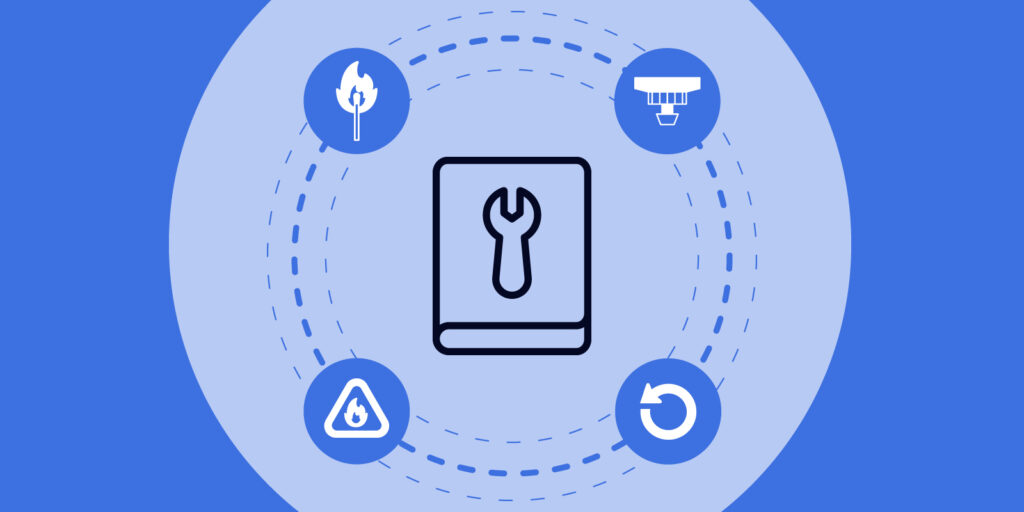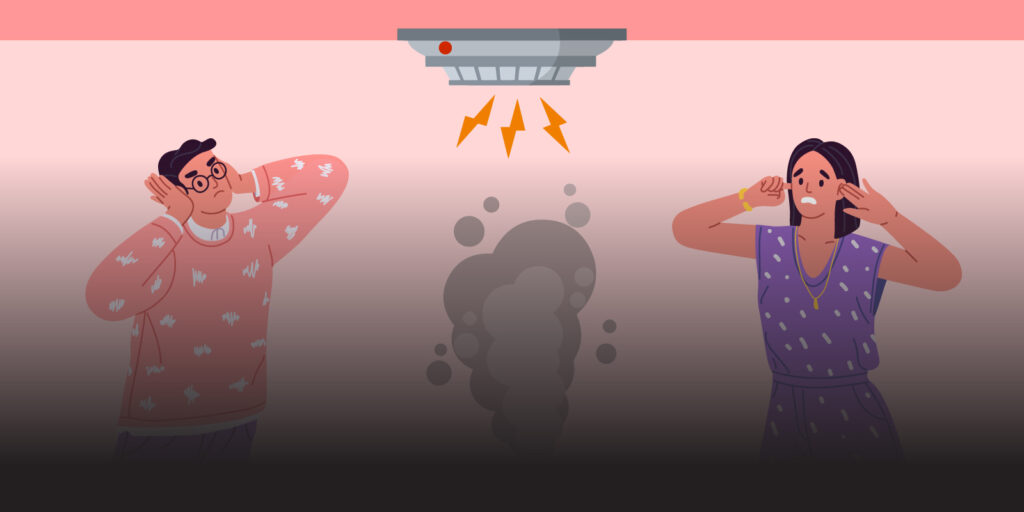Are you having trouble resetting your smoke alarm? Is that chirping sound to alert you that there is either a low battery or something else is wrong driving you nuts? You’re not alone. Smoke alarms are designed to detect potential fire safety concerns and alert homeowners about possible dangers, so it is important for them to be functioning correctly.
This blog post will provide all the information you need on how to properly reset a smoke alarm. We’ll go over everything from understanding why a smoke alarm needs to be reset in the first place, what types of problems might occur that could require resetting the unit, and finally, some key steps for successfully performing this important task yourself. Whether you’re just curious or need guidance now, we’ve got you covered. Keep reading to find out how to reset a smoke alarm in four easy steps.
What Is A Smoke Alarm And Why Is Resetting It Important?
A smoke alarm is a small device that detects smoke particles in the air and sounds an alarm to alert you of potential fire or smoke danger. Smoke alarms are typically installed on ceilings or walls in homes, apartments, and other buildings.
There are two main types of smoke alarms you will find in your home: ionization and photoelectric. Ionization smoke alarms detect small particles from fast-burning fires, while photoelectric smoke alarms detect larger particles from smoldering fires. Some newer models of smoke alarms use both types of detection methods for added safety.
Smoke alarms are a crucial part of any home, and resetting a smoke alarm after a false alarm is important to keep it reliable, as resetting it will remove any possible dust, insect pests, or other factors that could be preventing the device from working properly and accurately. Regularly testing and maintaining your smoke alarm not only ensures its effectiveness but also keeps you and your household safe in an emergency.
Hardwired vs. Battery-Operated
Before we can get into resetting your smoke alarm, it is important to know what type of smoke alarm system you are working with. Do you have a battery-powered or hardwired smoke alarm?
The main difference between a battery-operated and hardwired smoke alarm is the power source. Battery-operated smoke alarms are powered by lithium batteries, while hardwired smoke alarms are connected to the electrical wiring in your home.
Hardwired smoke alarms typically have a battery backup in case of a power outage, while battery-operated smoke alarms rely solely on their batteries. Hardwired smoke alarms may also be interconnected, meaning that if one goes off, all of the interconnected alarms will go off as well.
Both types of smoke alarms are definitely effective at detecting smoke and alerting you to potential fires. However, hardwired smoke alarms may be more reliable in terms of maintaining power and interconnectivity.
How to Reset a Smoke Alarm [Step-by-Step Guide]

Resetting a smoke alarm can be simple and stress-free with a few easy steps!
1. Locate the Test Button
First, locate the test or reset button located on the smoke detector. Once located, push and hold down until you hear the sound of a beep and/or flash—this notifies you that the alarm has been reset. And that’s it! Regular maintenance of your smoke alarm is also essential, so remember to follow these same steps at least once a month to ensure energy efficiency and safety. If the chirping noise is still continuing after you reset it, there are a few other steps you can take.
2. Check the Battery
There’s no mistaking the sound when your smoke alarm decides it’s time to change the battery—that high-pitched smoke alarm beeping is enough to make anyone jump out of their skin! But before you decide to unplug it in frustration, it’s essential to properly check the battery first.
Smoke alarms do, in fact, have expiration dates, and if your current one is near the end of its lifespan, you may need to upgrade. And don’t just take a guess or rely on previous owners; actually inspect the age of the battery if possible for best results. If you can’t tell the age, buying a new battery is your best bet. This small step can save you a world of trouble and help keep your home safe from fire-related danger!
If you have a hardwired smoke alarm, they do have batteries in case there is a power outage. If you need to replace the battery for a hardwired alarm, make sure to go to your circuit breaker and turn off the power before messing around with the battery compartment.
3. Clean the Sensor
Cleaning the sensor of your smoke alarm is an important part of making sure it can detect any fire hazards in your home. Before resetting it, use a vacuum to remove any visible dust or cobwebs that may be blocking the sensor. You can also purchase specialized foam cleaning swabs or a compressed air duster to ensure that the sensor is cleared of dirt and debris. Resetting your smoke alarm regularly can help keep you and your family safe from potential fires.
4. Test the Alarm
Don’t forget to test the smoke alarm! Testing that the alarm is working is an essential part of resetting a smoke alarm. Make sure you have all the necessary items handy, such as a ladder and a broom handle. Push your broom handle in the test button for about 5-15 seconds or until the alarm sounds. If it doesn’t sound, check if there are any loose connections or if its battery has run out of power and needs replacing. After you make sure it’s functioning properly, resetting a smoke alarm will become much easier.
Troubleshooting and Maintenance Tips for Your Smoke Alarm
It’s important to keep your smoke alarm running in its best condition. After all, it’s responsible for detecting fire or other hazardous conditions before they become a problem. To help keep the alarm working optimally, try troubleshooting it on a monthly basis and inspect it for dirt or debris that may be preventing it from doing its job. Don’t forget to dust the vents once every few months too. By taking these preventative steps, you can make sure your smoke alarm is always up to the task of protecting your home and family.
Make sure that before you reset, you turn off the power while testing or replacing any smoke alarm batteries. Resetting without turning off power can cause accidental activation of other alarms. Lastly, every couple of years, consider replacing the whole unit in order to ensure consistent functioning and safety coverage.
FAQs About Resetting A Smoke Alarm
Resetting a smoke alarm can be a scary proposition, especially if you’re not sure how to do it correctly. That’s why it’s important to know the basics before performing this task in your home. Here are a few commonly asked questions.
Do you need to replace the entire smoke alarm unit if your smoke alarm is chirping?
Not necessarily. If your smoke alarm is beeping, it could simply mean that the battery needs to be replaced. Most battery-operated smoke alarms will beep periodically to alert you when the battery is low and needs to be changed.
However, if replacing the battery doesn’t solve the problem, and the smoke alarm continues to beep, it may indicate a more serious issue with the unit itself. In this case, you should consult the manufacturer’s instructions or contact a professional to determine if the unit needs to be replaced.
Are smoke alarms and carbon monoxide alarms the same?
No, smoke alarms and carbon monoxide alarms are not the same. Smoke alarms detect smoke particles in the air, while carbon monoxide detectors detect the presence of carbon monoxide gas. Both are important for home safety and should be installed in every home.
How often should you replace your full smoke alarm unit?
The National Fire Protection Association (NFPA) recommends replacing smoke alarms every 10 years. After this time, the sensors in the unit may become less sensitive, and the device may not function properly.
However, it’s important to note that some manufacturers may recommend a shorter lifespan for their specific models. It’s always best to consult the manufacturer’s instructions for your particular smoke alarm to determine its recommended lifespan and replacement schedule.
Additionally, if your smoke alarm has been damaged or is not functioning properly, it should be replaced immediately, regardless of its age.
How do you know if your smoke alarm is hardwired?
If your smoke alarm is hardwired, it means that it is directly connected to the electrical wiring in your home. Here are some ways to determine if your smoke alarm is hardwired:
- Look for wires: If you see wires coming out of the back or sides of the smoke alarm, it is likely hardwired into your electrical system.
- Check the manual: The manufacturer’s instructions for your smoke alarm should indicate whether it is battery-operated or hardwired.
- Test the backup battery: Hardwired smoke alarms typically have a backup battery in case of a power outage. If you find a backup battery in your smoke alarm, it may be an indication that it is hardwired.
- Look at the age: Smoke alarms that were installed before 1990 are more likely to be hardwired since battery-operated models were not widely available until later.
If you are still unsure whether you have a hardwired smoke detector or not, consult a professional electrician for assistance.
Can you have both hardwired and battery-operated smoke alarms in your house?
Yes, it is possible and even recommended to have both hardwired and battery-powered smoke alarms in your house.
Having both types of smoke alarms provides an extra layer of protection for your home and family. In the event of a power outage or if the hardwired alarm malfunctions, the battery-powered alarm will still be operational.
The National Fire Protection Association (NFPA) recommends having at least one smoke alarm on every level of your home, including inside each bedroom and outside sleeping areas. It’s important to regularly test all smoke alarms in your home to ensure they are functioning properly and replace batteries as needed.
Wrapping It Up
Resetting your smoke alarm is an important yet simple task that can help ensure the safety of you and your family. If done properly, it can also extend its life and help it work more efficiently. It’s always important to stay up to date on what type of alarm you have, as well as their outlined safety instructions. Smoke alarms are an essential investment that can save lives, so make sure to keep yours up and running! If you have any questions or are worried about how you reset your smoke alarm, you can always reach out to an electrician for a second opinion and rest easy knowing your family is safe and sound at home.
Related: Fire Alarm Vs Smoke Detector [What’s The Difference?]




